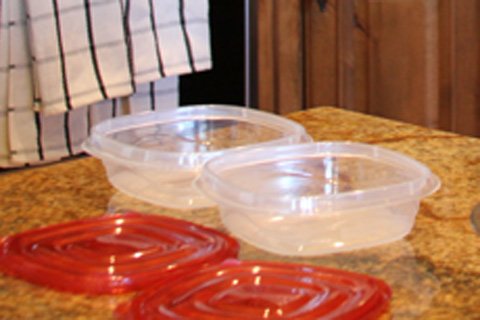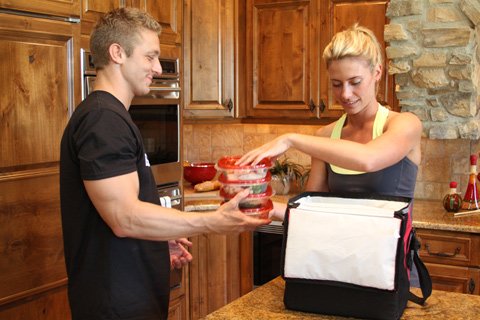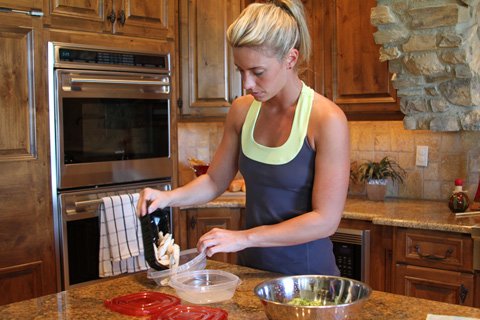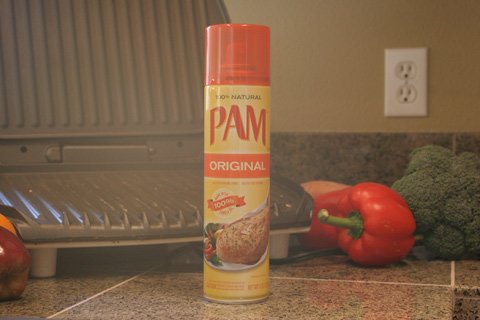4 Must-Read Food-Safety Tips For The Fit
If 80 percent of the results of your fitness program are based on your diet, should you spend 80 percent of your time preparing, cooking, and packing food?
Thankfully, no. Thanks to that miracle of modern technology, Tupperware, you can make large batches of meals in advance.
It's simple! No more worries about eating clean and staying healthy, right? Well, not so fast.
As you throw-and-go out the door with mountains of Tupperware-packed meals, you may be putting your health at risk. How? By making dangerous food-storage mistakes. So let's put your food storage under a microscope, shall we? Bacteria, chemicals, mold ... oh my!
These 4 mistakes can turn your stomach in more ways than one:
We've probably all done it at least once. "Hey, this container looks spotless. Why wash it?" You ask yourself this questions after having chowed down on dry chicken, brown rice, and green veggies. So you commit the "rinse and re-use" mistake, using the same food containers multiple times without a thorough wash.
Rinsing or wiping out leftover food debris doesn't make your Tupperware container clean! It's time to snip those bad habits that developed since moving out of your parent's house.
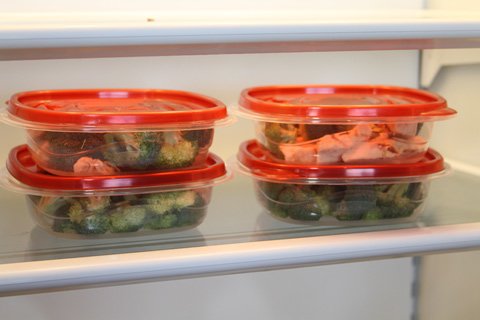
 Click To Enlarge.
Click To Enlarge.
The toxic radiation from these containers will give you something—and it's not super powers.
Yes, it can be inconvenient to wash your dishes with soap and water, or to have to wait for the dishwasher to fill up and finish a cleaning cycle before using your containers again.
But if you pick up your pair of bacteria spy goggles-everyone has a pair of those, right?-you'd see that even the thinnest amount of filmy asparagus water left in your Tupperware can easily start to sprout a colony of bacteria and mold!
Imagine Bacteria Disneyland populated by thousands of tiny, happy living organisms that just want to crawl inside your stomach and cause you to throw up or take a semi-permanent seat on the toilet.
Hopefully that image alone is enough to convince you to thoroughly wash your food containers, even if they look clean on the surface.
You might have heard the buzz, the word on the street, about how plastics that are heated may be harming our health. The speculation and arguments surrounding this controversy question whether plastic food storage containers that are reused over and over again may be leaking harmful chemicals into your food.
If you're really concerned with this potential issue, it's best to do your own research and stay up to date with scientific studies done on plastics. But, generally speaking, most Tupperware containers are considered to be safe. They're generally made from high-density polyethylene, low-density polyethylene, or polyethylene.
Apparently those forms of plastic are considered to be safe. So if your container is made out of polycarbonate, then you may want to be a little more careful about re-use, over-heating, and high-temperature dishwashers.
Polycarbonate has been suggested to release a potentially hormone-disrupting chemical referred to as Bisphenol A, which could put your health in jeopardy. If the containers that you use are made of polycarbonate material, you probably want to throw them away after one use.
| RELATED PRODUCT | ||
|
Another material to avoid when you buy multi-use food containers is polystyrene. You probably know this material by one of its more common forms-the Styrofoam cup, bowl, or box.
There are other types of plastics made from polystyrene that don't fall under the trademarked "Styrofoam" name, but they aren't as prevalently used as food-storage containers.
Styrofoam has been potentially linked to health problems with the skin, eyes, respiratory system, kidneys, and maybe even the central nervous system. Remember, the health dangers normally arise only when polystyrene products are affected by heat or are overused.
This doesn't have to be a major concern, as you probably won't purchase this type of material for Tupperware containers. But many restaurants use polystyrene containers to send you home with leftovers from your meal.
So it's always a good idea to remove the food from the container as soon as you arrive home and toss that container.
The temperature you store your foods at is critical to the health of food. Far too many people have a tendency to think that their food will be fine if they're just going for a few hours without temperature control.
Don't be fooled-a lot of the foods that meet the standards of a healthy diet need to be colder or warmer than you may think.
The common solution to keeping food cold is to just pack an empty cooler with your refrigerated food. But, if you aren't armed with a few icepacks, the cooler may not be cold enough to prevent the growth of food-borne bacteria.
Foods like chicken, seafood, eggs, various meat products, and any dishes prepared with mayonnaise must be kept below 4 degrees Celsius (39.2 degrees Fahrenheit) at all times. By tossing a freezer pack into your cooler you should solve this problem.
But if you're rolling with the big guns-a monster cooler fit for mountains of meals-you may want to consider using two or three ice packs to be on the safe side.
Another great accessory for any health-conscious dieter is an insulated lunch box. Purchase one that's big or small enough for your needs and will have a bit of extra room for an icepack.
Worrying about food staying cold isn't your only concern? If you're preparing a hot dish, you must keep it hot or chill it immediately, and then keep it cold until you reheat it once again.
Use thermoses where appropriate and keep these foods separate from the foods that have to stay cold.
As much as we all want to save money and only buy food containers to replace the ones we lose, your plastic containers can only last so long.
If you've had your containers for about a year, it may be time to think about recycling them and building a new inventory.
If you notice that your containers are cracking, warping badly, starting to flake, or bending more easily than before, then those are signs that the containers are shouting, "Replace me! Let me Rest. In. Peace."
The more you microwave and wash a container, the more likely that its lifespan will be shorter than you expect. The convenience of food storage containers is indisputable. But the containers themselves aren't indestructible.
Watch for the signs of aging in your food containers.
Final Tips on Food Storage
Think about sustainability, invest in quality stuff, and recycle! If you're committed to bringing 3 or 4 food storage containers to work every day, then food storage containers will be an important investment.
Think about picking high-quality containers that are BPA-free, microwave- and dishwasher-safe, and not prone to warping or staining. You may even want to shop for containers made from recycled materials and containers that are recyclable.
Find ways to increase the shelf life of your Tupperware. For one thing, if you tend to throw away any container that gets stained after one use by your favorite healthy chili or enchilada dish, there's a simple way to decrease the chances of staining: Spray the inside of the container with a non-stick cooking spray (a light coating will work) before you plop in your food.
Avoid marathon microwave sessions. Even the highest-quality containers can't withstand endless heat 'waves! You'll end up with a warped body or lid and inevitably toss the poor soul.
If you routinely microwave an entire chicken for lunch-hardgainers, you know what that's like-then consider picking up some glass storage containers or even microwave-safe porcelain.
Remember, you won't see the best results from your workout and diet if you end up shackled to the toilet for 24 hours or more.
Sickness can really set you back, so take all precautions when it comes to food storage. Your body will thank you!
Reference:
Recommended Articles
| Share This Article: |


